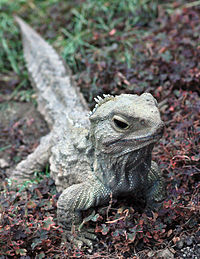
Photo from wikipedia
Eocene early‐diverging representatives of South American extinct notungulates are traditionally considered to have been “generalists” and “non‐specialized” in terms of the appendicular skeleton and locomotor behavior, as is the case… Click to show full abstract
Eocene early‐diverging representatives of South American extinct notungulates are traditionally considered to have been “generalists” and “non‐specialized” in terms of the appendicular skeleton and locomotor behavior, as is the case with the notostylopid Notostylops, a middle Eocene iconic taxon from Patagonia (Argentina). However, they are mainly known from dental remains, and associated cranial and postcranial elements are scarce. The discovery of a nearly complete specimen attributed to N. murinus allows us to: (1) increase the knowledge of the anatomy of its appendicular skeleton; (2) identify isolated bones from several collections and suggest different taxonomic interpretations for published specimens; (3) perform a biomechanical and functional study using functional morphological analysis to infer its paleoecological attributes (e.g. posture, locomotor habit, estimated speed, and body mass); and (4) establish morphofunctional comparisons, based on possible functional ranges, with other extinct early‐diverging notoungulates from the middle Eocene, such as the Notopithecid Notopithecus. Our evidence suggests that Notostylops was a medium‐sized mammal (8.5−20 kg), which could achieve a dynamic digitigrade posture that allowed a scansorial secondary locomotor habit and a speed of up to 50 km/h. However, Notopithecus was a small‐sized mammal (0.6−1.4 kg) with a plantigrade posture both in a static and dynamic context, terrestrial habits, and a speed of up to 35 km/h. Therefore, we conclude that these Eocene notoungulates show different locomotor capabilities, which can be associated with early niche diversifications, clearly contrasting with the “all‐generalists” paradigmatic view.
Journal Title: Journal of Morphology
Year Published: 2022
Link to full text (if available)
Share on Social Media: Sign Up to like & get
recommendations!